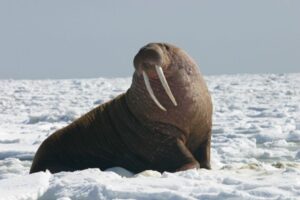LATIN NAME Odobenus rosmarus
LENGTH Males: 2.7m to 3.6m (9 ft – 12 ft) Females: 2.3m – 3.1m (7.5 ft – 10 ft)
WEIGHT Males: 800kg – 1,700kg (1,764 lb – 3,748 lb) Females: 400kg – 1,250kg (882 lb – 2,756 lb)
LIFETIME Approximately 40 years
PHYSICAL TRAITS A walrus has a rounded, fusiform body. Generally, walruses are cinnamon-brown overall. Limbs are adapted as flippers. A walrus’s head is square and broad with conspicuous tusks and whiskers. A walrus’s skin is thick and tough. It may reach a thickness of 2 to 4 cm (0.79-1.6 in). It is thickest on the neck and shoulders of adult males, where it protects the animal against jabs by the tusks of other walruses. They are of course distinguished by their long white tusks.
BEHAVIOR Walruses are among the most vocal of the pinnipeds having a range of anatomical specializations that can provide plasticity to their sound emissions. They produce growls, taps, knocks, grunts, barks, soft whistles, rasps, and clicks. Male walruses produce bell-like sounds below water.
HABITAT Walruses live in Arctic and sub-Arctic regions of the world near the North Pole. Most walruses live where the air temperature is about -15° to +5°C (5° – 41°F). Walruses are generally found where the water is no more than 80 m (262 ft.) deep. They prefer a habitat with a gravelly bottom. Walruses spend about two-thirds of their lives in the water.
LOCATIONS They can be found in the Pacific Ocean, Atlantic Ocean, and Arctic Ocean where there is sea ice.
FOOD They prefer feeding at the bottom of shallow waters, eating clams, mollusks, worms, snails, soft shell crabs, shrimp and sea cucumbers. Residing on the sea ice, they dive off the lead edges to forage on the sea bottom. Melt-back of the polar ice caps into deep waters threaten their feeding adaptations.
PREDATORS

